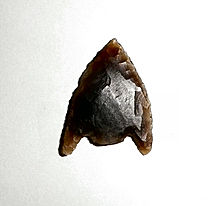|
|
|
|
Turning Stone and Robin Hoods MarkRocking Stone
|
||||||||||||||||||||||||
|
|
|
Images (click to view fullsize) |
|
Photographs:



 Artistic / Interpretive:
Artistic / Interpretive:


|
Fieldnotes |
|
|
Armed with machetes this time to cut through the rhodadendruns, we came across a tunnnel already cut through them, hands and knees stuff for about 50yds through the thick branches.....at the end of the tunnel there stands the Turning Stone. Sadly no longer rocking....looking at it I don't see how it ever did....but it's still a great looking lump of rock. The 'tunnels' go all the way along Overton Tor, sometimes only a few inches from the edge....and it's along way down. But there was no sign of Robin Hoods Mark. ............................................................................. Over the last few years I've recovered a handful of waste flint flakes in the fields close to Cocking Tor. |
17th April 2003ce Edited 19th August 2007ce |
|
I've been up on Overton Tor looking for the Turning Stone on and off for a while now. One of a pair of rocking stones, the other was known as 'Robin Hoods Mark', which was 26ft round and weighed 14 tons. I've never come across a size for the Turning St'. If they are still rocking, they may be somewhere amongst the mass of Rhododendruns, that run along the edge of the tor. There's just no way thru' them. The rock carvings at Ashover school are about 1mile away. |
27th March 2003ce Edited 31st March 2003ce |
Folklore |
|
There is in the Peak of Derbyshire a very remarkable rocking stone, called by the country people Robin Hood's Mark; it stands on the edge of a declivity near the top of a hill on Ashover common, looking down upon Overton hall, an estate of Sir Joseph Banks, Bart. the respectable President of the Royal Society, who will undoubtedly preserve this curious Druidical monument.From 'An Account of the Druidical Remains in Derbyshire. In a Letter to the Right Honourable Frederick Montague, FAS. By Hayman Rooke, Esq. FAS.' In Archaeologia v12 (1796). |
 Posted by Rhiannon
Posted by Rhiannon1st May 2013ce Edited 1st May 2013ce |
Miscellaneous |
|
|
"On the declivity of a hill on Ashover Common is a rocking stone, called by the people 'Robin Hood's Mark' which measures 26 feet in circumference, and from its extraordinary position evidently not only appears to have been a work of art, but to have been placed with great ingenuity. About 200 yards to the north of this is a singularly-shaped rock, called the 'Turning stone', in height 9 feet, supposed by Mr Rooke to have been a rock idol..." T. Bateman "Vesitiges of the Antiquities of Derbyshire. |
9th December 2007ce |
| Robin Hoods Mark is due south of the Turning Stone, on it's own, between the outcrops of Overton Tor and Cocking Tor. It has been wedged to prevent it from rocking. The Turning Stone never was a rocking stone. |
Posted by Turning Stone 1st June 2003ce Edited 22nd March 2013ce |
|
There doesn't seem to be many references to these rocking stones I first came across it on a geological map of Matlock; In Bulmers 'History of Derbyshire' from 1895 he mentions the two stones.. "As being some way connected with Druidical worship". Also the 'Gentlemans Library'. In their Derbyshire guide under ' Ancient State and Remains" the stones are one of the few sites mentioned. Along with Arbor Low and the infamous Hirst Stones at Riber. |
27th March 2003ce Edited 27th November 2007ce |

